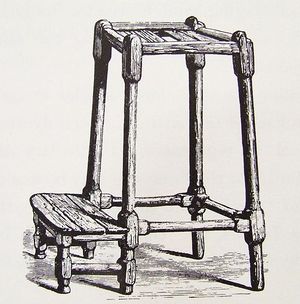Repentance stool

A repentance stool is a stool that was built specially for the purpose of doing public repentance for an offense such as adultery. In the 19th century, this kind of stool was known as a cutty stool.
The design of such a stool was that of a usual wooden stool, sturdy built with no back or arm rests, but possibly with a foot rest as shown in the drawing. The stool was not designed with particular discomfort in mind, but sitting on it shouldn't be too comfortable either.
An example of how the repentance-stool was used in history is told in the following story: Paul Methven, a minister at Jedburgh, Scotland, was found guilty of adultery in 1663. His sentence was to wear sackcloth at the church door and to sit on the repentance-stool for two Sundays each, and to do this in three towns: in Edinburgh, as the capital, in Dundee, as his native town, and in Jedburgh, the scene of his ministrations.
Similar stools
Schools used stools, chairs and benches for similar punitive purposes, for example the "corner stool" in which a boy or girl would be made to sit during corner time, sometimes wearing a dunce cap for additional shame. Today, this has largely come out of fashion in schools, but some parents still use a "naughty stool" as a variation of the naughty step time-out technique for young children.
In fiction, chairs and stools with spiked tops are sometimes used for corporal punishment -- see punishment stool for more on this subject.
Chat rooms • What links here • Copyright info • Contact information • Category:Root